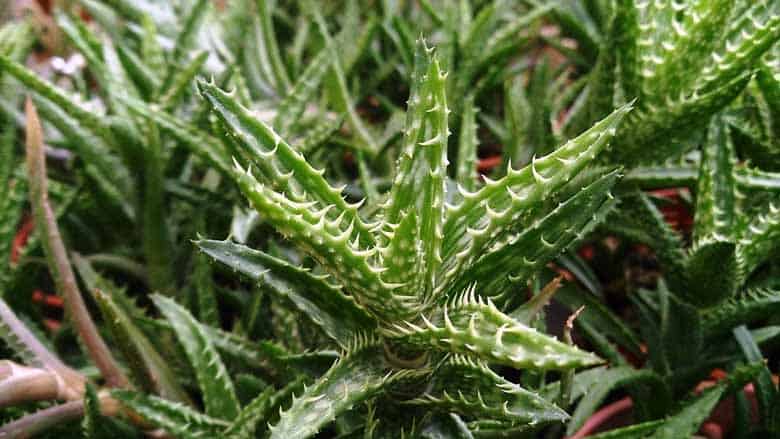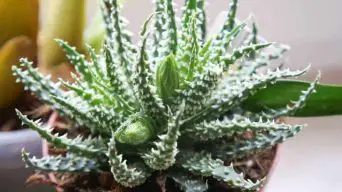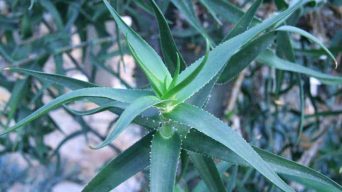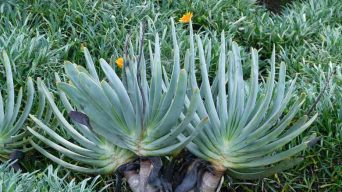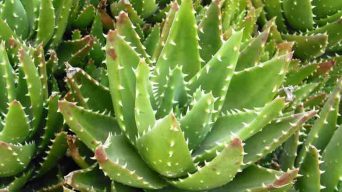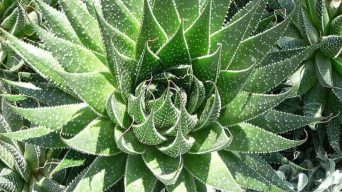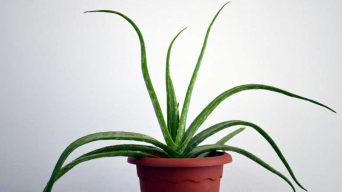One of the more popular species of Aloe plants is the Aloe juvenna, which is rare in its natural habitat.
The Aloe juvenna grows slowly but will eventually produce green-topped rosettes with long, pointed teeth, hence their common name, ‘Tiger Tooth Aloe’.
The Aloe juvenna requires little maintenance, making it perfect for those with limited time caring for plants.
This article will teach you how to take care of your Aloe juvenna, along with helpful tips on propagating this attractive succulent!
Overview
| Family: | Asphodelaceae |
| Genus: | Aloe |
| Botanical Name: | Aloe juvenna |
| Common Names: | Tiger Tooth Aloe |
| Origin: | Kenya |
| USDA Hardiness Zones: | 9 – 11 |
| Size: | 12 inches (30cm) tall and up to 24 inches (61cm) wide |
| Sun Exposure: | Full sun to partial shade |
| Water Needs: | Water thoroughly but infrequently |
| Soil Type: | Well-draining soil |
| Temperature: | 65° to 90° F (18°-32° C) |
| Humidity Levels: | 50-70% |
The Aloe juvenna, commonly known as the ‘Tiger Tooth Aloe’, is a succulent plant native to Kenya.
The Tiger Tooth Aloe is part of the Aloe genus and Asphodelaceae family. It grows in rocky and mountainous areas.
This plant can grow up to 12 inches (30 centimeters) tall. It produces rosettes typically up to 24 inches wide (61 centimeters).
The Aloe juvenna (Tiger Tooth Aloe) succulent plant has a rosette of spiked leaves.
One characteristic that gives the Aloe juvenna (Tiger Tooth Aloe) its name is its toothy protuberances on the leaves.
These spines are soft and flexible. They add an attractive touch rather than provide a defense measure for this succulent plant.
Tiger Tooth Aloe flowers are red to orange, appearing on an unbranched spike that can be up to 10 inches (25 cm) tall.
How To Care for Aloe Juvenna (Tiger Tooth Aloe)
Aloe juvenna care is not very complicated to do. Still, it’s essential to ensure that these plants are healthy and live for an extended period.
Sun Exposure & Light Requirements
Aloe juvenna (Tiger Tooth Aloe) thrives in full sun or partial shade. They do not like being in the shade for long periods.
They prefer low light conditions during the winter when Aloe juvenna plants are slow-growing.
When grown outdoors, Tiger Tooth Aloe plants need to be planted in a location where they will receive at least six hours of sunlight daily.
However, Aloe juvenna plants can survive in light shade conditions if they are given enough light.
During the winter, Aloe juvenna plants need at least four hours of sun daily to prevent any damage or harm.
The Aloe juvenna plant also needs this six-eight-hour sunlight duration during summer and spring for optimal growth.
When grown indoors, Aloe juvenna prefers indirect, bright natural light but will also tolerate low levels of artificial indoor lighting.
They need to be placed near a window that faces south or west so they will still receive plenty of bright light.
In addition, aloe juvenna plants need to be placed outside in late summer and early fall for at least six hours each day when the weather is warm.
They are native to areas with hard winter conditions. Still, They can grow indoors, too, if given enough sunlight from natural or artificial sources.
Watering Requirements
Water your Aloe juvenna succulents when the soil is completely dry to ensure they are hydrated and moist.
If you notice some of the lower leaves turning brown, water them as soon as possible.
This symptom means there has been a lack of moisture in the soil for too long, which can lead to stress on the plant’s root system.
If this happens, don’t wait until all parts become brown before watering again because it will likely be too late at this point, so act quickly!
Ensure you give them enough water so the dirt is wet all the way around and runoff comes from it.
Once aloes have established themselves, they don’t need to be watered often, so if you have yet to water in the last few weeks, it’s likely unnecessary.
Aloes like their soil on the dry side and should only be watered once every week or two. Aloes mustn’t be overwatered as this can lead to root rot, killing your aloe plant!
Soil Requirements
The Tiger Tooth Aloe plant prefers soil that is porous and well-drained. This is because Aloe juvenna has a taproot.
The soil should be well-drained and have good drainage to avoid overwatering problems.
A cactus/succulent soil mix is recommended for Aloe juvenna.
You should make the soil mixture with one part of potting soil, one part sand or perlite, and two peat moss. This will create a well-draining soil mix that allows the Aloe juvenna to thrive in low light conditions, as succulents prefer indirect sunlight or filtered sun only.
Do not use a soil mixture already mixed with fertilizer because aloe juvenna are sensitive to over-fertilization, which can kill them!
Temperature and Humidity
The Aloe juvenna succulent plant thrives in a temperature range of 65° to 90° Fahrenheit (18°-32° Celsius).
Higher temperatures are needed for the summer and lower temperatures during the winter.
You should maintain the humidity level between 50% and 70%.
The best way to keep the Tiger Tooth Aloe succulent plant at a comfortable temperature is by maintaining it in an environment with plenty of light.
You can place the Aloe juvenna plant near a south-facing window or outside during sunny days in cooler weather.
If possible, use natural sunlight since this will have more heat than artificial light sources, which emit less radiation (heat).
If your Aloe juvenna does not receive enough warmth for optimal growth due to location or other factors, carefully move it close to a heater until temperatures return to normalcy.
However, keep in mind that direct exposure to heating devices may cause dehydration, so monitor closely for any adverse reactions.
Fertilizing
The Aloe juvenna succulent does not require fertilizer, but feeding your plants will result in healthier plants and encourage blooms.
It’s best to fertilize your succulents in the spring and summer. Using a diluted liquid fertilizer is recommended.
Fertilize Aloe juvenna plants once a month during the growing season. Do not fertilize aloes in winter or early spring when they’re going dormant.
Potting and Repotting
Aloe juvenna plants are relatively slow-growing in terms of growth and will only need to be repotted occasionally.
Plants need to be repotted into a slightly larger container every few years to avoid becoming root-bound.
When repotting aloes, do not damage the waxy coatings on their leaves.
Keep them in a well-draining soil mix and provide ample drainage at the bottom of pots for complete plant health.
Pruning
The most common reason people prune Aloe juvenna is for aesthetics.
Some owners find that removing old or damaged leaves improves their appearance.
In contrast, others want to maintain specific heights so that everything neatly fits together instead of being randomly scattered.
- Remove any leaves that are brown, brittle, or damaged in any way. These will create dead weight for your aloe plant, which can lead to its death if left untreated.
- Remove any aloe leaves where the base is beginning to turn black. These aloes are infected with a virus and eventually become an unsightly mess that you should remove quickly before spreading.
- Remove aloe leaves growing in an unnatural direction, usually near the ground. This may be because they have been damaged and will not grow back correctly.
- Cut away any aloes which completely cover the base of their support stake. These aloes should be removed as they are unlikely to heal properly if left alone.
Some aloes can also benefit from being cut down to a small size; this ensures more room around the plant and provides fresh airflow, which helps with growth.
Pests and Diseases
Aloe juvenna succulent plants are susceptible to pests and diseases.
Keep an eye out for the following:
- Aloe mite
- Aloe gall wasp
- Mealybugs
- Aloe leaf spot fungus (Phytophthora cinnamomi)
- Powdery mildew (Erysiphe polygoni)
- Thrips.
These can be treated with neem oil or a combination of insecticidal soap containing pyrethrin/pyrethrins peppermint extract and a horticultural sulfur-based fungicide.
The Aloe juvenna plants are also susceptible to aloe wilt disease.
Treatment is complex because it can be slow and spread over a large area. Still, the use of systemic fungicides will help control its spread.
How to Care for Aloe Juvenna (Tiger Tooth Aloe) in Winter
Aloe juvenna is not cold hardy, and will need to be taken inside for the winter.
The Tiger Tooth Aloe should not be overwatered in winter but watered lightly once a week.
If you live where there are cold spells and freezing nights, place your Aloe juvenna outside during the day and bring it back indoors at night after sunset when the temperature drops below 45 degrees Fahrenheit.
The Aloe juvenna is a succulent plant with thick leaves that store water in the stem.
During winter, this will help keep your succulent from drying out and dying during periods when you cannot provide adequate watering.
If there are any branches on your aloe juvenna, cut them off to prevent rot growth or injury.
If desired, you can also pot up some of these cuttings for propagation purposes.
Keep an eye out for pests like mealybugs and caterpillars while taking care of Aloe juvenna in winter.
How To Propagate Aloe Juvenna (Tiger Tooth Aloe)
There are three ways to propagate the Aloe juvenna: offsets, division, or stem cuttings.
Offsets
The offsets are replicas of the Aloe juvenna and will grow into the same plant.
Choose a healthy offset from the mother plant that is not too close to other aloes.
Use a sharp blade or glass cutter to cut off an offset from one of the rosettes, making sure not to damage any roots in the process.
Put the Tiger Tooth Aloe offset on a potting mix.
The aloe offset should be positioned upright.
Water the aloe juvenna and put it in a sunlit area to encourage the growth of new roots, which will take about two weeks.
After that, you can plant your aloe juvenna offset on its own pot or with other plants in an open garden bed.
Division
If you want to divide a large Aloe juvenna, the plant must have enough leaves and roots.
Keep in mind that a Tiger Tooth Aloe should be healthy before dividing.
Separate a mature plant into three parts with a sharp blade or glass cutter.
Once separated, let them dry out for about one hour to maintain their structure and water uptake capacity. Afterward, repot them on new potting mix soil.
The aloes grow well together as long as there are at least six inches between plants when planting them outside pots.
Stem Cuttings
The Aloe juvenna stem cuttings give the quickest and easiest way to propagate.
Choose a healthy Aloe juvenna with at least six leaves, about one foot high. Cut off its leaf base from the main trunk, so it has a solid place to attach roots.
Plant the aloe plant in potting mix soil or directly in an open garden bed with enough sunlight to grow it (around four to six hours).
Water new Aloe Juvennas with purified water every day until they grow some roots, usually two weeks after planting them outside their pots.
Is the Aloe Juvenna (Tiger Tooth Aloe) Toxic?
Aloes are generally considered toxic to cats, dogs, and pets. However, aloes like Aloe juvenna are not poisonous to humans.
As a precaution, it is always recommended to keep aloes out of reach of pets and children and wear gloves when handling aloe plants to avoid contact with the sap.
In some cases, aloes may cause skin irritation or allergic reaction in humans, including redness and blistering of the skin that can last from hours up to several days after exposure.
In these instances, it’s recommended that you immediately wash off aloe gel residue for relief.
Final Thoughts
In conclusion, Aloe juvenna plants are beautiful to grow and can be propagated easily. This is an excellent plant for anyone who wants to have a nice-looking succulent in their home.
And if you add to this its low maintenance needs, Aloe juvenna plants are one of the best aloes to grow.

